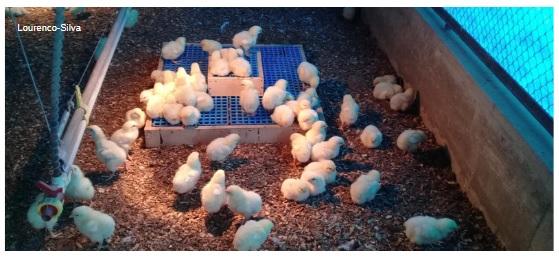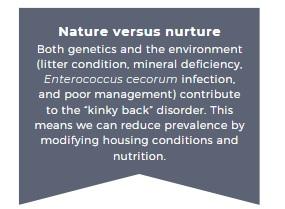What can we do today to reduce the problem?
Kinky back (spondylolisthesis) in broiler chickens




- Perching platforms with or without ramps depending on the height
- Straw or hay bales
- Laser light projections onto the floor


- Kinky back can negatively affect fast-growing broilers even without obvious signs.
- Kinky back is a multifactorial disorder. There is no magical solution, as both genetic and environmental factors impact the prevalence.
- Environmental resources stimulate exploratory behaviors and exercise, strengthening the birds’ musculoskeletal systems.
- Environmental complexity can reduce subclinical spondylolisthesis prevalences in broilers.
Abbasabadi, B. M., Golshahi, H., & Seifi, S. (2021). Pathomorphologial investigation of spondylolisthesis leaded to spondylosis in commercial broiler chicken with posterior paralysis: A case study. Veterinary Research Forum, 12(2), 263–265.
Almeida Paz, I., Garcia, R., Bernardi, R., Nääs, I., Caldara, F., Freitas, L., Seno, L., Ferreira, V., Pereira, D., & Cavichiolo, F. (2010). Selecting appropriate bedding to reduce locomotion problems in broilers. Brazilian Journal of Poultry Science, 12(3), 189–195.
Crespo, R., & Shivaprasad, H. L. (2008). Developmental, metabolic and other diseases. In Y. M. SAIF, A. M. FADLY, J. R. GLISSON, L. R. MCDOUGALD, L. K. NOLAN, & D. E. SWAYNE (Eds.), Diseases of poultry (12th ed., p. 1159). Blackwell publishing.
Dinev, I. (2012). Pathomorphological investigations on the incidence of clinical spondylolisthesis ( kinky back ) in different commercial broiler strains. Revue Med Vet, 163(11), 511–515.
Howlett, C. R., & Wood, A. K. W. (1984). A radologic and pathologic study of paresis in broiler chickens associated with noninfectious vertebral abnormalities. Veterinary Radiology, 25(2), 72–72.
Julian, R. J. (2004). Evaluating the Impact of Metabolic Disorders. In C. A. Weeks & A. Butterworth (Eds.), Measuring and auditing broiler welfare (pp. 51–59). CABI Publishing.
Kelly, W. R. (1971). Occurrence of spondylolisthesis (kinky-back) in broiler chickens in South Australia. Australian Veterinary Journal, 47(73).
Lourenço da Silva, M. I., Almeida Paz, I. C. de L., Chaves, G. H. C., Almeida, I. C. de L., Ouros, C. C. dos, Souza, S. R. L. de, Milbradt, E. L., Caldara, F. R., Satin, A. J. G., Costa, G. A. da, & Glavina, A. S. G. (2021). Behaviour and animal welfare indicators of broiler chickens housed in an enriched environment. PLOS ONE, 16(9), e0256963.
Lourenço da Silva, M. I., Almeida Paz, I. C. de L., Jacinto, A. S., Nascimento Filho, M. A., Oliveira, A. B. S. de, Santos, I. G. A. dos, Mota, F. dos S., Caldara, F. R., & Jacobs, L. (2023). Providing environmental enrichments can reduce subclinical spondylolisthesis prevalence without affecting performance in broiler chickens. PLOS ONE, 18(4), e0284087.
Osbaldiston, G. W. (1967). Spondylolisthesis and leg weakness in the chicken-a common etiology. Veterinary Record, 80, 320–322.
Wise, D. R. (1970). Spondylolisthesis (‘Kinky Back’) in Broiler Chickens. Research in Veterinary Science, 11(5), 447–455.
Wise, D. R. (1973). The Incidence and Aetiology of Avian Spondylolisthesis (‘Kinky Back’). Research in Veterinary Science, 14(1), 1–10.












.jpg&w=3840&q=75)